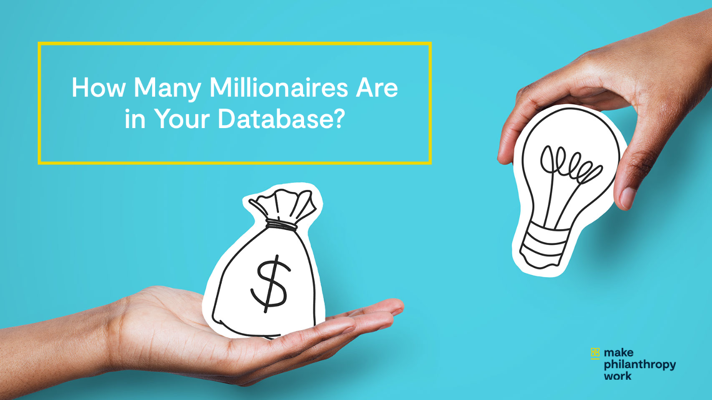Look in Your Own Fundraising Yard for Gifts
Stop looking at your neighbor’s lawn. Just too many nonprofits think the grass is greener with...
Scroll Down

How many millionaires are in your database who love your mission? Nonprofits are accustomed to setting goals. If you work in development, you most likely have revenue goals, expense goals, donor visit goals and ticket sales or event participant goals, but have you ever set a goal to identify the wealthiest individuals in your database? What would it look like if you started by identifying anyone in your database that is a millionaire?
According to a recent Global Wealth Report, an estimated 20 million Americans are millionaires. That’s approximately 8% of all adults living in the US.
Could your donors possibly match this percentage? Let’s say you have 1,000 donors in your database. Based on the statistics, there may be as many as 80 millionaires already in your donor pool. Do you know who they are?
Some of the most generous millionaires I’ve met during my nonprofit career have been people who poured their time and energy into their small businesses for decades and now have the fruit to show for their hard work. They have been plumbers, dairy farmers, and gym owners. Many of them live modestly and may not outwardly look like a millionaire. They may have invested early on in real estate or stocks that have performed well. In some instances, they’ve sold their companies for tens of millions of dollars.
It might surprise you to learn that there are millionaires in your CRM system waiting to be cultivated. They may be a faithful volunteer, an annual ticket holder, a grateful patient, or an in-kind corporate vendor with a heart for your mission.
By identifying individuals who have a high affinity for your organization and also the capacity to give, you will be well on your way to developing a strong major gift portfolio. After all, the best major gift prospects are people who are committed to the mission of your organization and desire to help you succeed.
A nonprofit can spend years, not to mention thousands of dollars cultivating donors. Still, if the donors they are cultivating do not have the resources to make a major gift or are not inclined to be generous, the effort is in vain. At MPW, we believe too many nonprofits are unintentionally cultivating and soliciting the wrong donors.
Identifying the right donors to cultivate is the first building block of any strong major gift portfolio. By investing time, energy, and resources in pinpointing the donors you and your staff should focus on, you will be helping your organization grow more strategically to achieve your revenue goals.
Are you ready to invest in prospect identification before you spend time, energy, and money focused on donors who do not have the capacity to give large gifts? Imagine what your major gift program would look like one year from now if you started taking these steps today?
If all of this seems overwhelming, consider enlisting support. MPW has packages available that offer prospect identification research and training resources to help you and your team utilize your existing database to create a strong pipeline. Contact us at inof@makephilanthropywork.com to learn more.
Stop looking at your neighbor’s lawn. Just too many nonprofits think the grass is greener with...
Help Donors Give Smarter As you prepare for your end-of-year campaigns, remember to highlight tax...
One client that we’ve worked with had an annual operating budget of approximately $1M, but the...